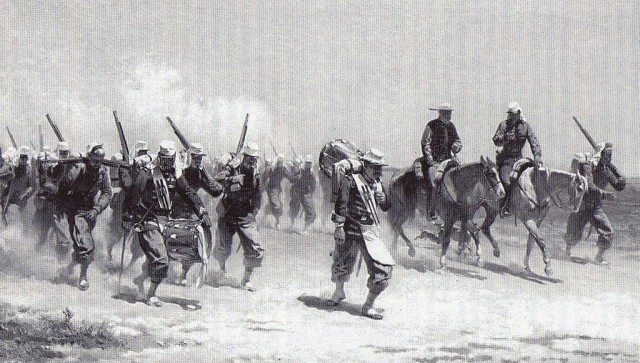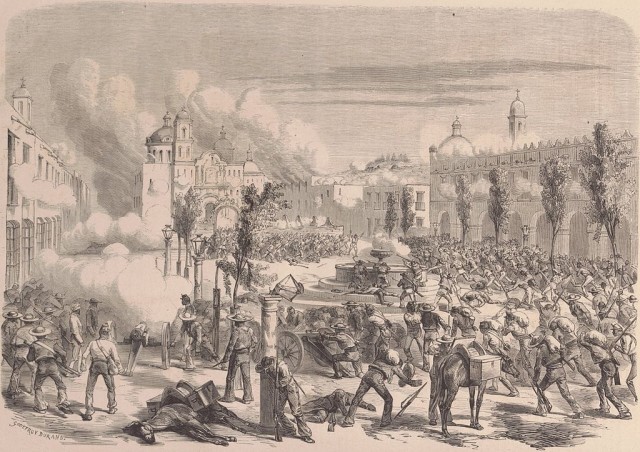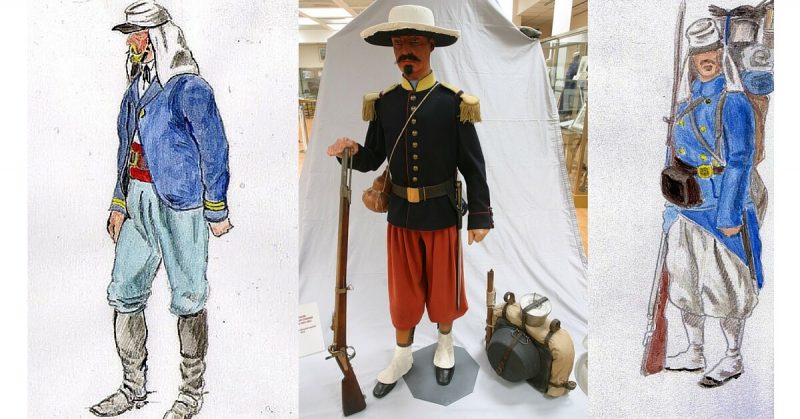The “Belgian Legion” was a loose term defining the service of Belgian troops in the French Army. The involvement of Belgians in the French military campaigns dates from the Revolutionary Wars from 1792 to 1802, when a group of Belgian volunteers went to aid the First French Republic.
They were from territories then known as the Austrian Netherlands (modern-day Belgium) and the Prince-Bishopric of Liege and led by General Louis Lahure. General Lahure was a veteran of the Brabant revolution that occurred several years earlier and was set against the Austrian dynasty, the Habsburgs, who held Belgium. It is also referred to as the Belgian Revolution of 1789-90, for the insurrection strived for freedom and political independence of the Belgian people.
Lahure, joined Napoleon in his conquest as so did the Belgians who followed him. This was the original Belgian Legion. In 1814, when the Austrians temporarily seized control over Belgium once again after Napoleon I was exiled to the island of Elba, the Belgian Legion was restored as a reserve force unit under the Austrian command. The Austrians managed to recruit several military regiments from the region, whose role was to reinforce the Austrian position, in the case of a French counter-attack.
That same year, the provisional government was established under the Duke of Beaufort, which provided further recruitment. The Belgian Legion was now under the command of Count von Murray, a Belgian-born Austrian General. The unit lost its primary role as a strike force of the French Army and became a law-enforcement element in the newly established Austrian province.
In 1848, another revolutionary turmoil was upon Europe and the Second French Empire was the epicenter of it . In March 1848, Belgian residents of Paris formed the Belgian Democratic Association (Association des démocrates Belges) and decided to carry the revolution home. They were led by a wine merchant called Blervacq and an aged officer, Fosses. There were around 6,000 Belgians gathered around the movement.
This was the birth of the new Belgian Legion. Informally, they were supported by several French Republican politicians who hoped that an insurrection in the South Netherlands, where the Legion was headed, will subsequently lead to the annexation of the area by France. Blervacq and Fosses were joined by a Belgian politician, Charles Gravaux and 1100 of students of the military academy, Ecole Polytechnique. The men departed Paris on the 25th March, unarmed but eager to overthrow the monarchy in the Southern Netherlands.
At first, they received support by General Negrier and a commissioner of the Department Nord Louis Charles Delescluze who resupplied them in Northern France, close to the border with Belgium. Both men were sympathizers of the Republic and they decided, on their hand, to aid the Belgian Legion on their conquest.
However, the French were ordered to stand down, by order of the French Minister of War, Louis-Eugene Cavaignac, who stressed out that no violations of the Belgian sovereignty will be tolerated. Both Delescluze and Negrier were still in government service and decided to obey.
Negrier ordered the military academy cadets to turn back and forbid the Belgian Legion to enter the city of Lille. The Belgians revolted and plundered the weapons and ammunition magazines of the French Army. Soon after crossing the Belgian border they encountered the Belgian Army and in a short skirmish known as the Risquons-Tout incident. The Legion dispersed with minimal casualties and retreated to France.

It was not until 1867 that the Belgian Legion has revived again, this time within the Second French Empire. The French managed to gain the support of Britain and Spain to intervene in Mexico in late 1861 in an event later called the Mexican Adventure, or the Franco-Mexican War. Louis Napoleon III, the Emperor of the Second French Empire claimed that the Second Mexican Republic was refusing to repay its loans to European countries, including Spain and Britain, and demanded a military intervention in defense of European honor and free trade.
The Emperors real reasons weren’t so noble since he knew that the establishment of a puppet monarchy in Mexico would allow him to hold a trade monopoly in Latin America. The British and the Spanish withdrew their support when they realized the French were planning not only to intervene for debt repayment but also to conquer Mexico. Louis Napoleon III proclaimed Maximillian I Habsburg as the new emperor of Mexico since he wanted to smooth his relations with the Austrian court. The affair lasted from 1861 to 1867, when the French withdrew from Mexico losing the war to President Benito Juarez and his guerillas.
During the war, the French summoned the Belgian volunteers to join their war effort against the Mexican republicans. To strengthen their esprit du corps, Louis Napoleon pointed out that Emperor Maximillian’s wife, Charlotte, was the daughter of Leopold I of Belgium, who was the first king of the independent Belgian Kingdom, loved and respected by the people.
Officially named “The Belgian Expeditionary Corps” this Legion was comprised of an infantry regiment of two battalions – the “Empress Battalion” of grenadiers and the “King of the Belgian’s Battalion” of voltigeurs. The officers and non-commissioned officers were mainly drawn from the regular Belgian Army as were some of the other ranks.
The Belgians formed part of a much larger “Imperial Mexican Corps of Austrian and Belgian Volunteers”, though they served separately from the Austrian contingent which was brigaded with Mexican Imperial troops.

The first detachment of the Belgian Legion, numbering 604 men, embarked for Mexico on 16 October 1864. Three further contingents were sent over the next three months, bringing the total force up to about 1,500. The Legion’s first encounter with the Mexican Republican forces was at the Battle of Tacámbaro on 11 April 1866, where a Belgian detachment of 300 men was forced to surrender after losing up to a third of its strength.
The remainder of the Belgian Legion performed well in subsequent clashes but on the 12th December 1866 the force was disbanded, and 754 of the contingent returned to Belgium where they dispersed.
A group of elderly members of the Belgian Legion attended the honorary funeral of Queen Charlotte in 1927, escorting her coffin. Soon, there were no surviving members of the Belgian Legion, even though Belgium and France continued to aid each other in times of need throughout the 20th century in both World Wars, and, more recently, in the War on Terror.
